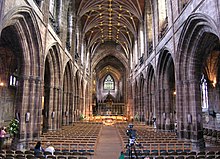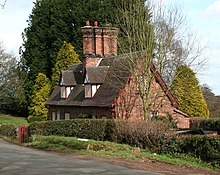Portal:Cheshire
|
The Cheshire Portal
WelcomeCheshire Plain from the Mid Cheshire Ridge
Cheshire is a ceremonial county in the North West of England. Chester is the county town, and formerly gave its name to the county. The largest town is Warrington, and other major towns include Congleton, Crewe, Ellesmere Port, Macclesfield, Nantwich, Northwich, Runcorn, Sandbach, Widnes, Wilmslow and Winsford. The county is administered as four unitary authorities. Cheshire occupies a boulder clay plain (pictured) which separates the hills of North Wales from the Peak District of Derbyshire. The county covers an area of 2,343 km2 (905 sq mi), with a high point of 559 m (1,834 ft) elevation. The estimated population is a little over one million, 19th highest in England, with a population density of around 450 people per km2. The county was created in around 920, but the area has a long history of human occupation dating back to before the last Ice Age. Deva was a major Roman fort, and Cheshire played an important part in the Civil War. Predominantly rural, the county is historically famous for the production of Cheshire cheese, salt and silk. During the 19th century, towns in the north of the county were pioneers of the chemical industry, while Crewe became a major railway junction and engineering facility. Selected articleChester Cathedral is a Church of England cathedral dedicated to Christ and the Blessed Virgin Mary. It became the cathedral of the city of Chester in 1541, and has been the centre of worship, administration, ceremony and music for both city and diocese since that date. A Christian basilica is believed to have occupied the site in the late Roman era, and an abbey church containing a shrine to St Werburgh, patron saint of the city, was destroyed in 1090. The present cathedral was formerly the abbey church of a Benedictine monastery founded by Hugh Lupus in 1093. The existing building in New Red Sandstone dates from between the foundation and the early 1500s. Monastic buildings survive to the north of the cathedral. Extensive restorations were carried out during the 19th century, notably by George Gilbert Scott, and a free-standing bell tower, designed by George Pace, was added in the 1970s. The site is a major tourist attraction, and the cathedral is used for concerts and exhibitions. Selected imageEaton Chapel was built in 1869–84 for Hugh Grosvenor, 1st Duke of Westminster, as the private chapel for Eaton Hall. An example of the Gothic Revival style with Alfred Waterhouse as the architect, the grade-I-listed chapel was retained when Waterhouse's hall was demolished in the 1960s. Credit: Peter I. Vardy (4 April 2010) In this monthNovember 1867: Grosvenor Park, Chester (pictured) opened. 1 November 1831: Harry Atkinson, Premier of New Zealand, born in Broxton. 4 November 1553: Lawyer Roger Wilbraham born in Nantwich. 7 November 1805: Railway builder Thomas Brassey born in Bulkeley. 11 November 1662: Lawyer John Chesshyre born in Halton. 14 November 1762: Tarporley Hunt Club first met. 15 November 1941: Author Heathcote Williams born in Helsby. 22 November 1961: Pianist Stephen Hough born in Heswall. 24 November 1935: Cyclist Vin Denson born in Chester. 24 November 1955: Cricketer Ian Botham born in Heswall. 26 November 1574: River Weaver in Nantwich flooded, affecting 40 dwellings and 24 salthouses. 29 November 1933: Musician John Mayall born in Macclesfield. Selected listChester city walls surround the medieval extent of Chester. The circuit of the walls extends for 2 miles (3 km), rises to a height of 40 feet (12.2 m), and "is the most complete circuit of Roman and medieval defensive town wall in Britain." The walls and associated structures are a scheduled monument, and almost all parts are listed, mainly at grade I. The walls originated between 70 and 90 AD as defences for the Roman fortress of Deva Victrix. The earliest walls were earth ramparts surmounted by wooden palisades, with wooden gates and towers. Rebuilding in sandstone started at the end of the 1st century and took over 100 years. The existing circuit was completed by the end of the 12th century. The four main gates were replaced during the 18th and early 19th centuries. By the 18th century the walls were becoming popular as a promenade, and £1,000 (equivalent to £210,000 in 2023) was spent in 1707 on repairs and paving the footway. Distinguished visitors who walked the walls at that time included John Wesley and Samuel Johnson. They remain a significant tourist attraction. GeographyTop: Map of modern Cheshire showing urban areas (grey) and the major road network. Chester (red) is the county town, and Warrington has the greatest population. Towns with more than 10,000 inhabitants in 2011 are highlighted; the size of dot gives a rough indication of the relative population. Wales and the adjacent English counties are shown in capitals. Bottom: Relief map showing the major hills. The Mid Cheshire Ridge is a discontinuous ridge of low hills running north–south from Beacon Hill (north of Helsby Hill) to Bickerton Hill. Most other high ground falls within the Peak District in the east of the county. Shining Tor (559 metres), on the boundary with Derbyshire, forms the county's high point. Administration The ceremonial county of Cheshire is administered by four unitary authorities (click on the map for details): 2 – Cheshire East 3 – Warrington 4 – Halton In the local government reorganisation of 1974, Cheshire gained an area formerly in Lancashire including Widnes and Warrington. The county lost Tintwistle to Derbyshire, part of the Wirral Peninsula to Merseyside, and a northern area including Stockport, Altrincham, Sale, Hyde, Dukinfield and Stalybridge to Greater Manchester. Selected biographyJohn Douglas (11 April 1830 – 23 May 1911) was an English architect, practising in Chester. Pevsner described him, without qualification, as "the best Cheshire architect". Born in Sandiway, his father was a former labourer who rose to be a surveyor. He trained with Edmund Sharpe and Edward Graham Paley in Lancaster, and later practised with Paley. Other early influences included Pugin and the Cambridge Camden Society. He set up his own practice in Chester in 1860, working with Daniel Fordham, Charles Minshall and his two surviving sons. His early buildings were High Victorian; he later became an important practitioner of the half-timbered revival style. Douglas' most popular works are the black-and-white buildings on Chester's St Werburgh Street and the nearby Eastgate Clock. Many of his works are on the Eaton Hall estate of the 1st Duke of Westminster, an important patron. He also designed churches, large houses and many smaller properties. Did you know...
Selected town or villagePeckforton is a scattered settlement and civil parish covering 1,754 acres (710 ha), near Malpas. The population was around 150 in 2006. The Peckforton Hills form the western part of the parish, with high points at Peckforton Point and Stanner Nab (around 200 metres). They are the source of the Weaver and Gowy rivers. Part of Peckforton Woods, largely planted in 1922, form a Site of Special Scientific Interest. The hills have been quarried since the Roman era. Peckforton appears in the Domesday survey of 1086. The area is predominantly agricultural. The earliest surviving buildings date from the early 17th century. Peckforton and the adjacent Beeston were part of an estate purchased by John Tollemache in 1840. He had Peckforton Castle – a mansion designed by Anthony Salvin in imitation of a medieval castle – built at the northern end of the Peckforton ridge. A local stone mason carved an elephant bearing a castle in red sandstone from the same quarry. Many of the local buildings were constructed for Tollemache using brick in the 1860s and 1870s. In the news29 October, 1 November: Warrington council and the mayor of Crewe each announce plans to bid for city status in 2022. 13–14 October: Prince Edward visits Chester and opens a Fire Service training centre in Winsford. 8 October: Castle Street shopping area in Macclesfield reopens after refurbishment. 4 October: Restoration of the grade-I-listed Bridgegate, part of Chester city walls, is completed. 25 September: A bronze frieze by the sculptor Tom Murphy is unveiled in Warrington, as a memorial to the band Viola Beach. 9 September: The fifth stage of the Tour of Britain cycle race takes place in Cheshire, starting at Alderley Park and finishing in Warrington. 24 July: The grade-II-listed Crewe Market Hall (pictured) formally reopens after refurbishment. 15 July: Crewe, Runcorn and Warrington are awarded potential funding under the "Town Deal" government scheme. QuotationThe ayr is very wholesome, insomuch that the people of the countrey are seldom infected with Diseases or Sicknesse, neither do they use the help of the Physicians, nothing so much, as in other countries: For when any of them are sick, they make him a posset, and tye a kerchieff on his head; and if that will not amend him, then God be merciful to him! The people there live till they be very old; some are Grandfathers, their Fathers yet living; and some are Grandfathers before they be married. From The Vale Royall of England by Daniel King (1656)
Subcategories
TopicsRecommended articlesThings you can do
WikiProject Related portalsAssociated WikimediaThe following Wikimedia Foundation sister projects provide more on this subject:
Discover Wikipedia using portals |







































